Leadership and Management: Motivational Strategy in Workplace (Unit 4)
VerifiedAdded on 2023/06/14
|10
|2524
|110
Report
AI Summary
This report provides an analysis of leadership and management in the workplace, focusing on motivational strategies and the application of leadership and management theories. It defines the roles of leaders and managers, differentiates between hard and soft skills, and examines the effectiveness of leadership and management approaches within organizations like Amazon, Walmart and Apple. The report also compares different leadership styles, such as transformational, transactional, democratic, and visionary leadership, and evaluates their impact on organizational culture and performance. Ultimately, the report concludes that effective leadership and management are crucial for guiding employees, fostering innovation, and achieving organizational objectives, while also acknowledging potential negative impacts of certain leadership styles on employee morale and retention.
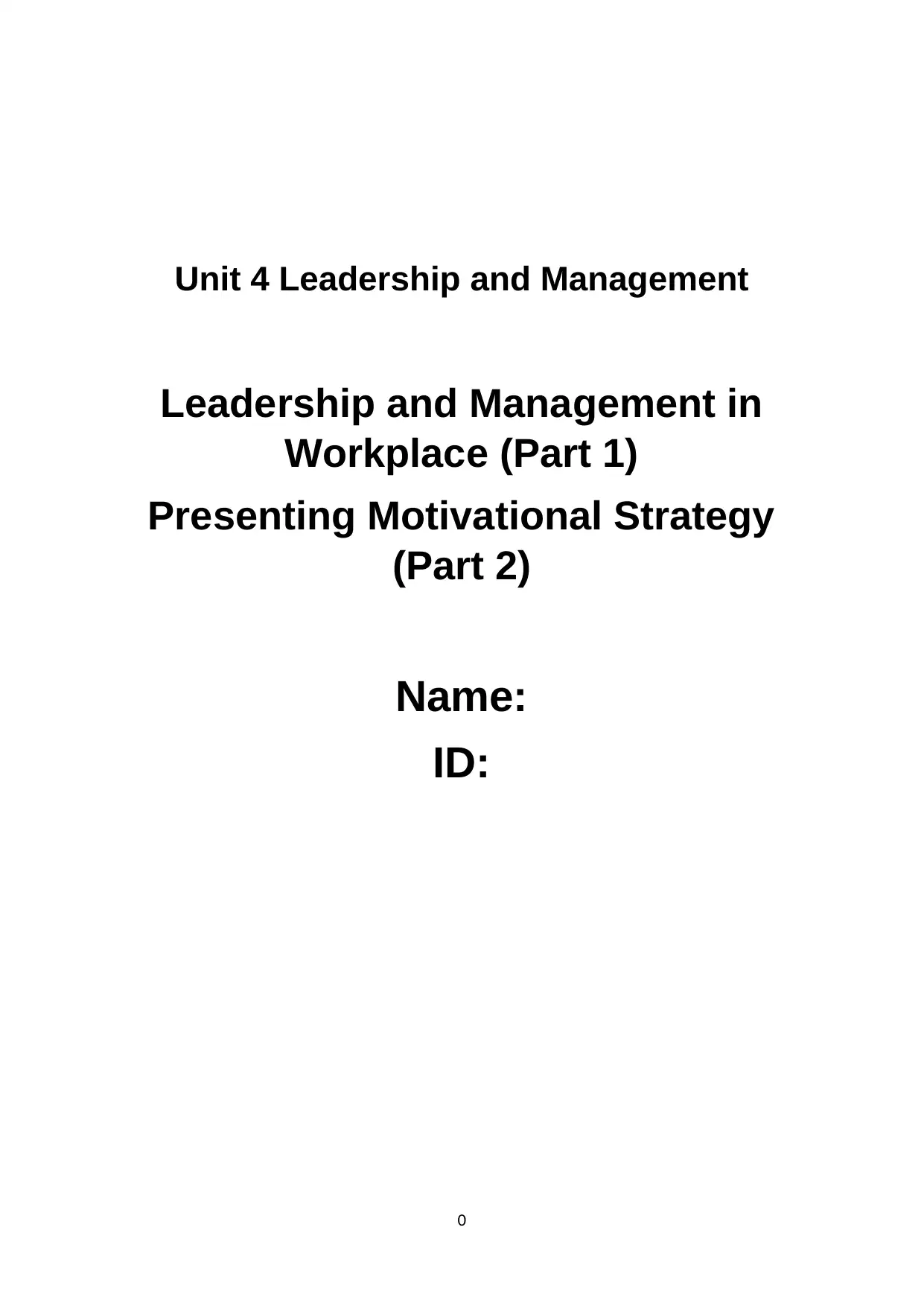
Unit 4 Leadership and Management
Leadership and Management in
Workplace (Part 1)
Presenting Motivational Strategy
(Part 2)
Name:
ID:
0
Leadership and Management in
Workplace (Part 1)
Presenting Motivational Strategy
(Part 2)
Name:
ID:
0
Paraphrase This Document
Need a fresh take? Get an instant paraphrase of this document with our AI Paraphraser
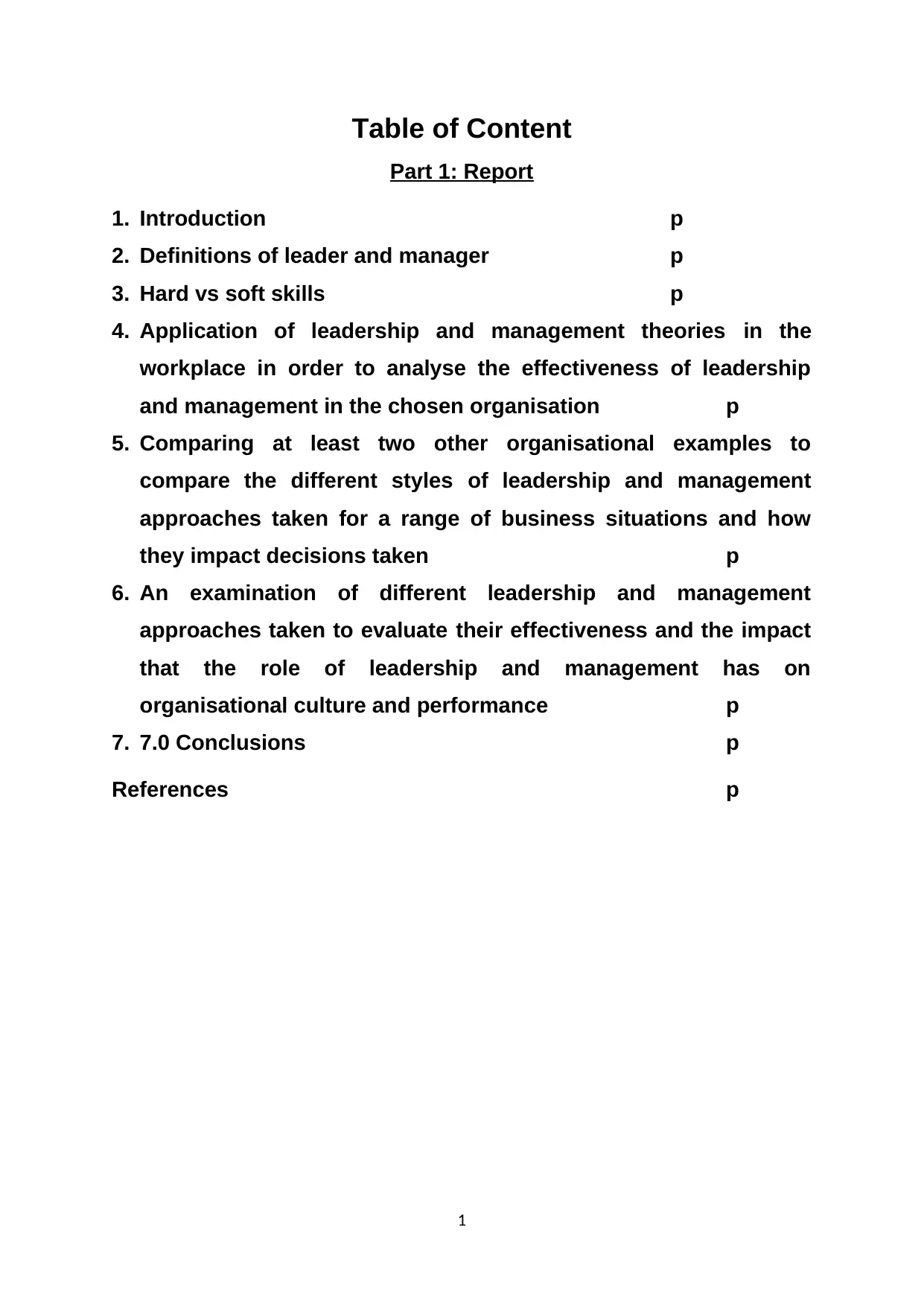
Table of Content
Part 1: Report
1. Introduction p
2. Definitions of leader and manager p
3. Hard vs soft skills p
4. Application of leadership and management theories in the
workplace in order to analyse the effectiveness of leadership
and management in the chosen organisation p
5. Comparing at least two other organisational examples to
compare the different styles of leadership and management
approaches taken for a range of business situations and how
they impact decisions taken p
6. An examination of different leadership and management
approaches taken to evaluate their effectiveness and the impact
that the role of leadership and management has on
organisational culture and performance p
7. 7.0 Conclusions p
References p
1
Part 1: Report
1. Introduction p
2. Definitions of leader and manager p
3. Hard vs soft skills p
4. Application of leadership and management theories in the
workplace in order to analyse the effectiveness of leadership
and management in the chosen organisation p
5. Comparing at least two other organisational examples to
compare the different styles of leadership and management
approaches taken for a range of business situations and how
they impact decisions taken p
6. An examination of different leadership and management
approaches taken to evaluate their effectiveness and the impact
that the role of leadership and management has on
organisational culture and performance p
7. 7.0 Conclusions p
References p
1
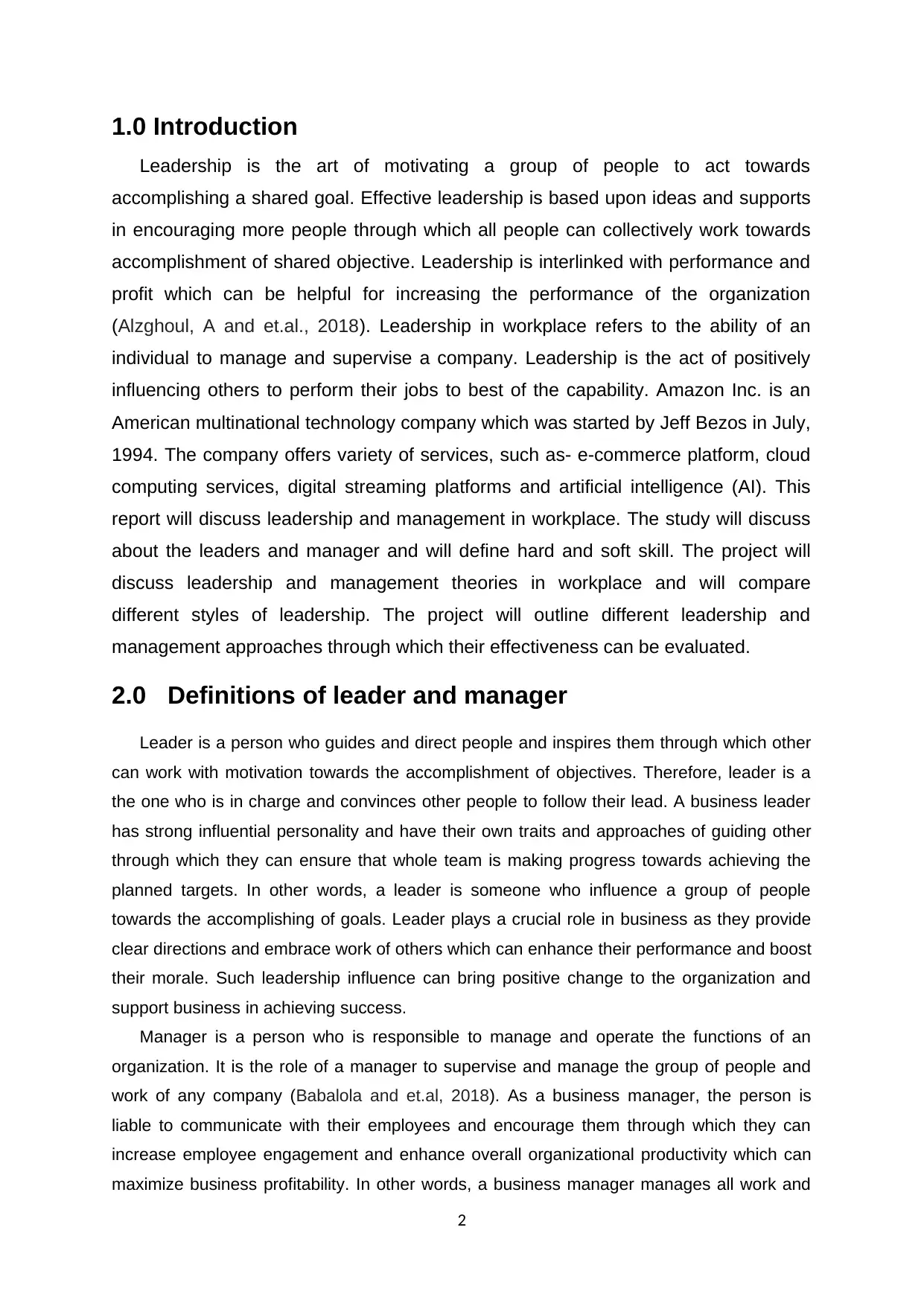
1.0 Introduction
Leadership is the art of motivating a group of people to act towards
accomplishing a shared goal. Effective leadership is based upon ideas and supports
in encouraging more people through which all people can collectively work towards
accomplishment of shared objective. Leadership is interlinked with performance and
profit which can be helpful for increasing the performance of the organization
(Alzghoul, A and et.al., 2018). Leadership in workplace refers to the ability of an
individual to manage and supervise a company. Leadership is the act of positively
influencing others to perform their jobs to best of the capability. Amazon Inc. is an
American multinational technology company which was started by Jeff Bezos in July,
1994. The company offers variety of services, such as- e-commerce platform, cloud
computing services, digital streaming platforms and artificial intelligence (AI). This
report will discuss leadership and management in workplace. The study will discuss
about the leaders and manager and will define hard and soft skill. The project will
discuss leadership and management theories in workplace and will compare
different styles of leadership. The project will outline different leadership and
management approaches through which their effectiveness can be evaluated.
2.0 Definitions of leader and manager
Leader is a person who guides and direct people and inspires them through which other
can work with motivation towards the accomplishment of objectives. Therefore, leader is a
the one who is in charge and convinces other people to follow their lead. A business leader
has strong influential personality and have their own traits and approaches of guiding other
through which they can ensure that whole team is making progress towards achieving the
planned targets. In other words, a leader is someone who influence a group of people
towards the accomplishing of goals. Leader plays a crucial role in business as they provide
clear directions and embrace work of others which can enhance their performance and boost
their morale. Such leadership influence can bring positive change to the organization and
support business in achieving success.
Manager is a person who is responsible to manage and operate the functions of an
organization. It is the role of a manager to supervise and manage the group of people and
work of any company (Babalola and et.al, 2018). As a business manager, the person is
liable to communicate with their employees and encourage them through which they can
increase employee engagement and enhance overall organizational productivity which can
maximize business profitability. In other words, a business manager manages all work and
2
Leadership is the art of motivating a group of people to act towards
accomplishing a shared goal. Effective leadership is based upon ideas and supports
in encouraging more people through which all people can collectively work towards
accomplishment of shared objective. Leadership is interlinked with performance and
profit which can be helpful for increasing the performance of the organization
(Alzghoul, A and et.al., 2018). Leadership in workplace refers to the ability of an
individual to manage and supervise a company. Leadership is the act of positively
influencing others to perform their jobs to best of the capability. Amazon Inc. is an
American multinational technology company which was started by Jeff Bezos in July,
1994. The company offers variety of services, such as- e-commerce platform, cloud
computing services, digital streaming platforms and artificial intelligence (AI). This
report will discuss leadership and management in workplace. The study will discuss
about the leaders and manager and will define hard and soft skill. The project will
discuss leadership and management theories in workplace and will compare
different styles of leadership. The project will outline different leadership and
management approaches through which their effectiveness can be evaluated.
2.0 Definitions of leader and manager
Leader is a person who guides and direct people and inspires them through which other
can work with motivation towards the accomplishment of objectives. Therefore, leader is a
the one who is in charge and convinces other people to follow their lead. A business leader
has strong influential personality and have their own traits and approaches of guiding other
through which they can ensure that whole team is making progress towards achieving the
planned targets. In other words, a leader is someone who influence a group of people
towards the accomplishing of goals. Leader plays a crucial role in business as they provide
clear directions and embrace work of others which can enhance their performance and boost
their morale. Such leadership influence can bring positive change to the organization and
support business in achieving success.
Manager is a person who is responsible to manage and operate the functions of an
organization. It is the role of a manager to supervise and manage the group of people and
work of any company (Babalola and et.al, 2018). As a business manager, the person is
liable to communicate with their employees and encourage them through which they can
increase employee engagement and enhance overall organizational productivity which can
maximize business profitability. In other words, a business manager manages all work and
2
⊘ This is a preview!⊘
Do you want full access?
Subscribe today to unlock all pages.

Trusted by 1+ million students worldwide
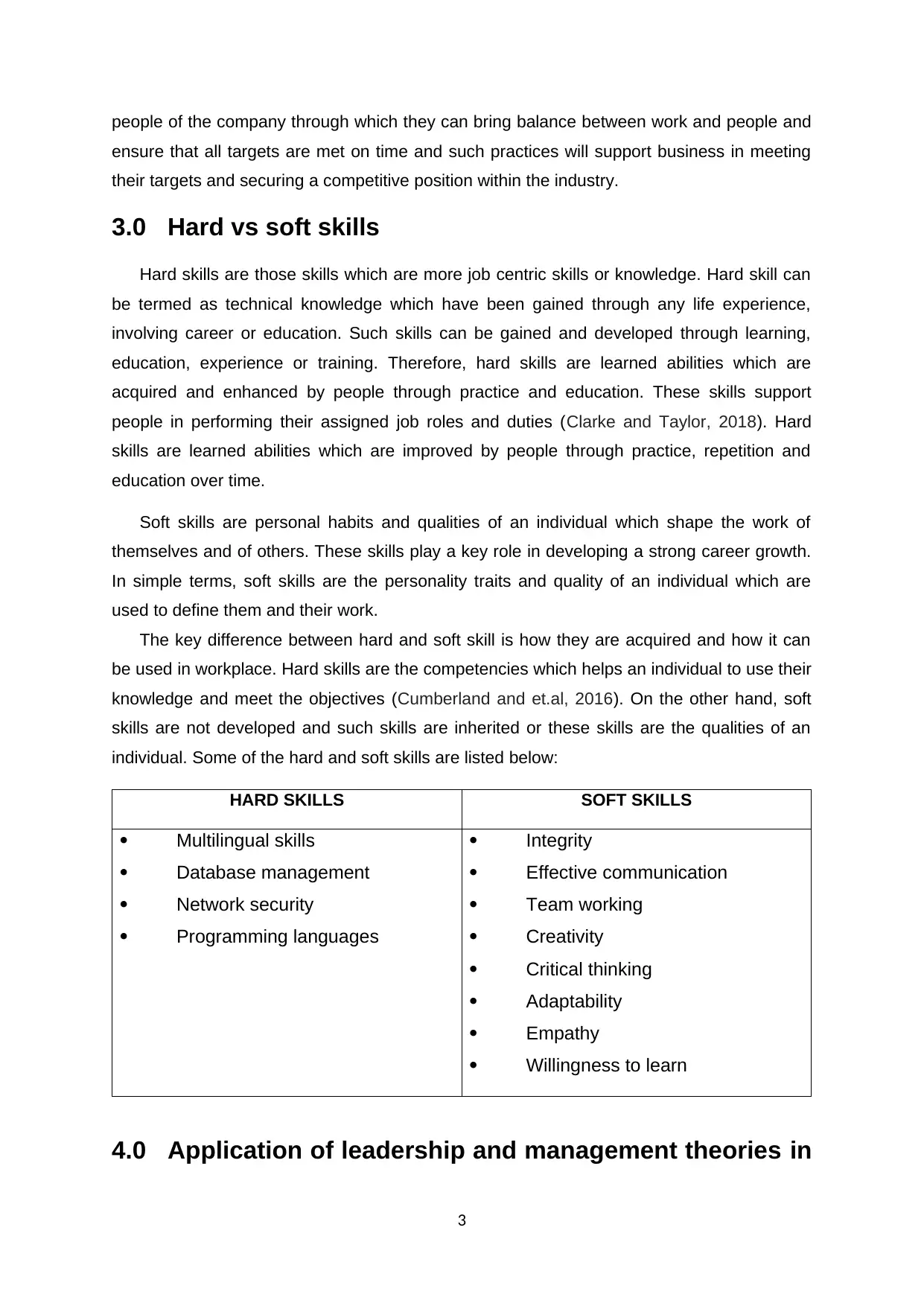
people of the company through which they can bring balance between work and people and
ensure that all targets are met on time and such practices will support business in meeting
their targets and securing a competitive position within the industry.
3.0 Hard vs soft skills
Hard skills are those skills which are more job centric skills or knowledge. Hard skill can
be termed as technical knowledge which have been gained through any life experience,
involving career or education. Such skills can be gained and developed through learning,
education, experience or training. Therefore, hard skills are learned abilities which are
acquired and enhanced by people through practice and education. These skills support
people in performing their assigned job roles and duties (Clarke and Taylor, 2018). Hard
skills are learned abilities which are improved by people through practice, repetition and
education over time.
Soft skills are personal habits and qualities of an individual which shape the work of
themselves and of others. These skills play a key role in developing a strong career growth.
In simple terms, soft skills are the personality traits and quality of an individual which are
used to define them and their work.
The key difference between hard and soft skill is how they are acquired and how it can
be used in workplace. Hard skills are the competencies which helps an individual to use their
knowledge and meet the objectives (Cumberland and et.al, 2016). On the other hand, soft
skills are not developed and such skills are inherited or these skills are the qualities of an
individual. Some of the hard and soft skills are listed below:
HARD SKILLS SOFT SKILLS
Multilingual skills
Database management
Network security
Programming languages
Integrity
Effective communication
Team working
Creativity
Critical thinking
Adaptability
Empathy
Willingness to learn
4.0 Application of leadership and management theories in
3
ensure that all targets are met on time and such practices will support business in meeting
their targets and securing a competitive position within the industry.
3.0 Hard vs soft skills
Hard skills are those skills which are more job centric skills or knowledge. Hard skill can
be termed as technical knowledge which have been gained through any life experience,
involving career or education. Such skills can be gained and developed through learning,
education, experience or training. Therefore, hard skills are learned abilities which are
acquired and enhanced by people through practice and education. These skills support
people in performing their assigned job roles and duties (Clarke and Taylor, 2018). Hard
skills are learned abilities which are improved by people through practice, repetition and
education over time.
Soft skills are personal habits and qualities of an individual which shape the work of
themselves and of others. These skills play a key role in developing a strong career growth.
In simple terms, soft skills are the personality traits and quality of an individual which are
used to define them and their work.
The key difference between hard and soft skill is how they are acquired and how it can
be used in workplace. Hard skills are the competencies which helps an individual to use their
knowledge and meet the objectives (Cumberland and et.al, 2016). On the other hand, soft
skills are not developed and such skills are inherited or these skills are the qualities of an
individual. Some of the hard and soft skills are listed below:
HARD SKILLS SOFT SKILLS
Multilingual skills
Database management
Network security
Programming languages
Integrity
Effective communication
Team working
Creativity
Critical thinking
Adaptability
Empathy
Willingness to learn
4.0 Application of leadership and management theories in
3
Paraphrase This Document
Need a fresh take? Get an instant paraphrase of this document with our AI Paraphraser
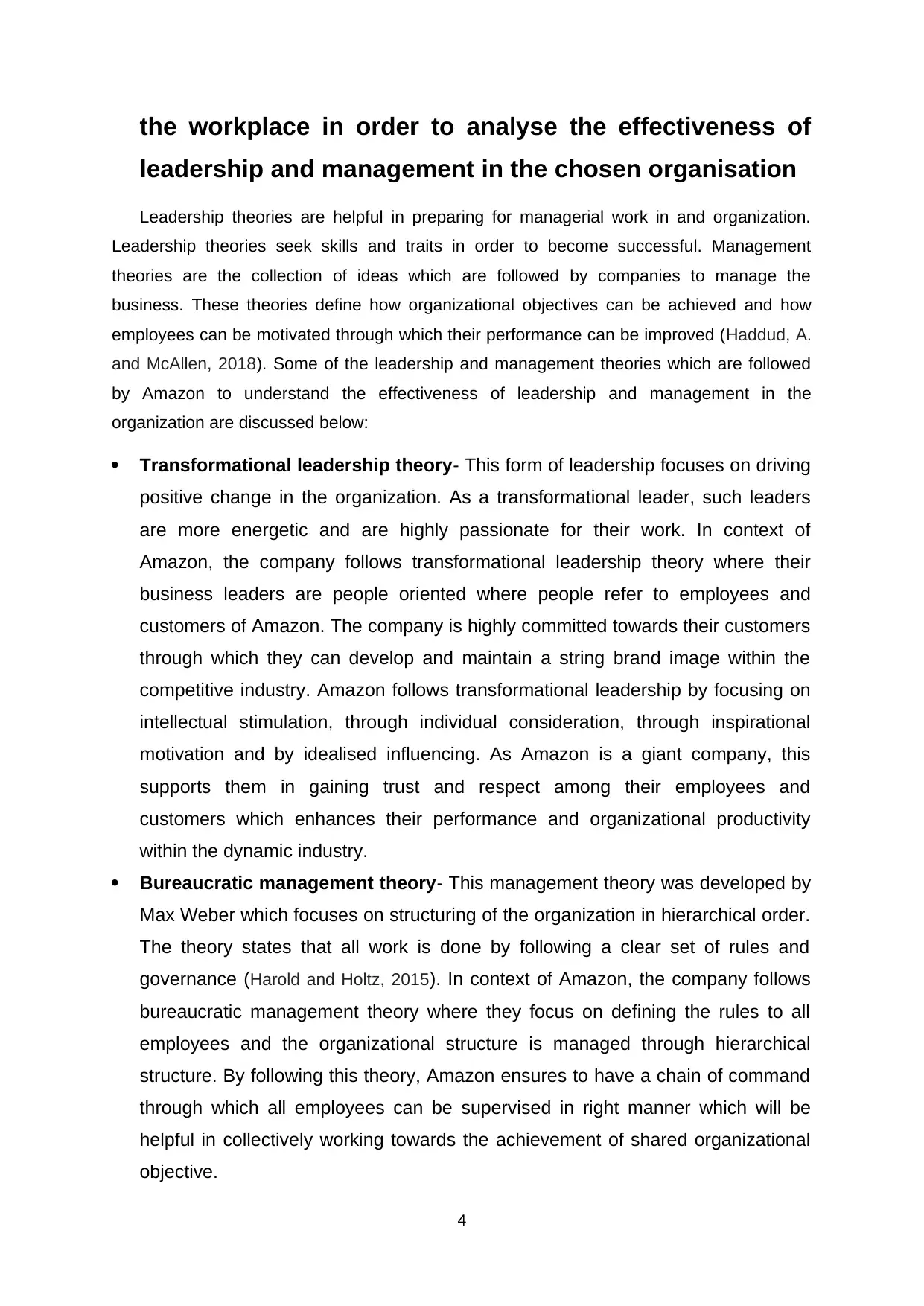
the workplace in order to analyse the effectiveness of
leadership and management in the chosen organisation
Leadership theories are helpful in preparing for managerial work in and organization.
Leadership theories seek skills and traits in order to become successful. Management
theories are the collection of ideas which are followed by companies to manage the
business. These theories define how organizational objectives can be achieved and how
employees can be motivated through which their performance can be improved (Haddud, A.
and McAllen, 2018). Some of the leadership and management theories which are followed
by Amazon to understand the effectiveness of leadership and management in the
organization are discussed below:
Transformational leadership theory- This form of leadership focuses on driving
positive change in the organization. As a transformational leader, such leaders
are more energetic and are highly passionate for their work. In context of
Amazon, the company follows transformational leadership theory where their
business leaders are people oriented where people refer to employees and
customers of Amazon. The company is highly committed towards their customers
through which they can develop and maintain a string brand image within the
competitive industry. Amazon follows transformational leadership by focusing on
intellectual stimulation, through individual consideration, through inspirational
motivation and by idealised influencing. As Amazon is a giant company, this
supports them in gaining trust and respect among their employees and
customers which enhances their performance and organizational productivity
within the dynamic industry.
Bureaucratic management theory- This management theory was developed by
Max Weber which focuses on structuring of the organization in hierarchical order.
The theory states that all work is done by following a clear set of rules and
governance (Harold and Holtz, 2015). In context of Amazon, the company follows
bureaucratic management theory where they focus on defining the rules to all
employees and the organizational structure is managed through hierarchical
structure. By following this theory, Amazon ensures to have a chain of command
through which all employees can be supervised in right manner which will be
helpful in collectively working towards the achievement of shared organizational
objective.
4
leadership and management in the chosen organisation
Leadership theories are helpful in preparing for managerial work in and organization.
Leadership theories seek skills and traits in order to become successful. Management
theories are the collection of ideas which are followed by companies to manage the
business. These theories define how organizational objectives can be achieved and how
employees can be motivated through which their performance can be improved (Haddud, A.
and McAllen, 2018). Some of the leadership and management theories which are followed
by Amazon to understand the effectiveness of leadership and management in the
organization are discussed below:
Transformational leadership theory- This form of leadership focuses on driving
positive change in the organization. As a transformational leader, such leaders
are more energetic and are highly passionate for their work. In context of
Amazon, the company follows transformational leadership theory where their
business leaders are people oriented where people refer to employees and
customers of Amazon. The company is highly committed towards their customers
through which they can develop and maintain a string brand image within the
competitive industry. Amazon follows transformational leadership by focusing on
intellectual stimulation, through individual consideration, through inspirational
motivation and by idealised influencing. As Amazon is a giant company, this
supports them in gaining trust and respect among their employees and
customers which enhances their performance and organizational productivity
within the dynamic industry.
Bureaucratic management theory- This management theory was developed by
Max Weber which focuses on structuring of the organization in hierarchical order.
The theory states that all work is done by following a clear set of rules and
governance (Harold and Holtz, 2015). In context of Amazon, the company follows
bureaucratic management theory where they focus on defining the rules to all
employees and the organizational structure is managed through hierarchical
structure. By following this theory, Amazon ensures to have a chain of command
through which all employees can be supervised in right manner which will be
helpful in collectively working towards the achievement of shared organizational
objective.
4
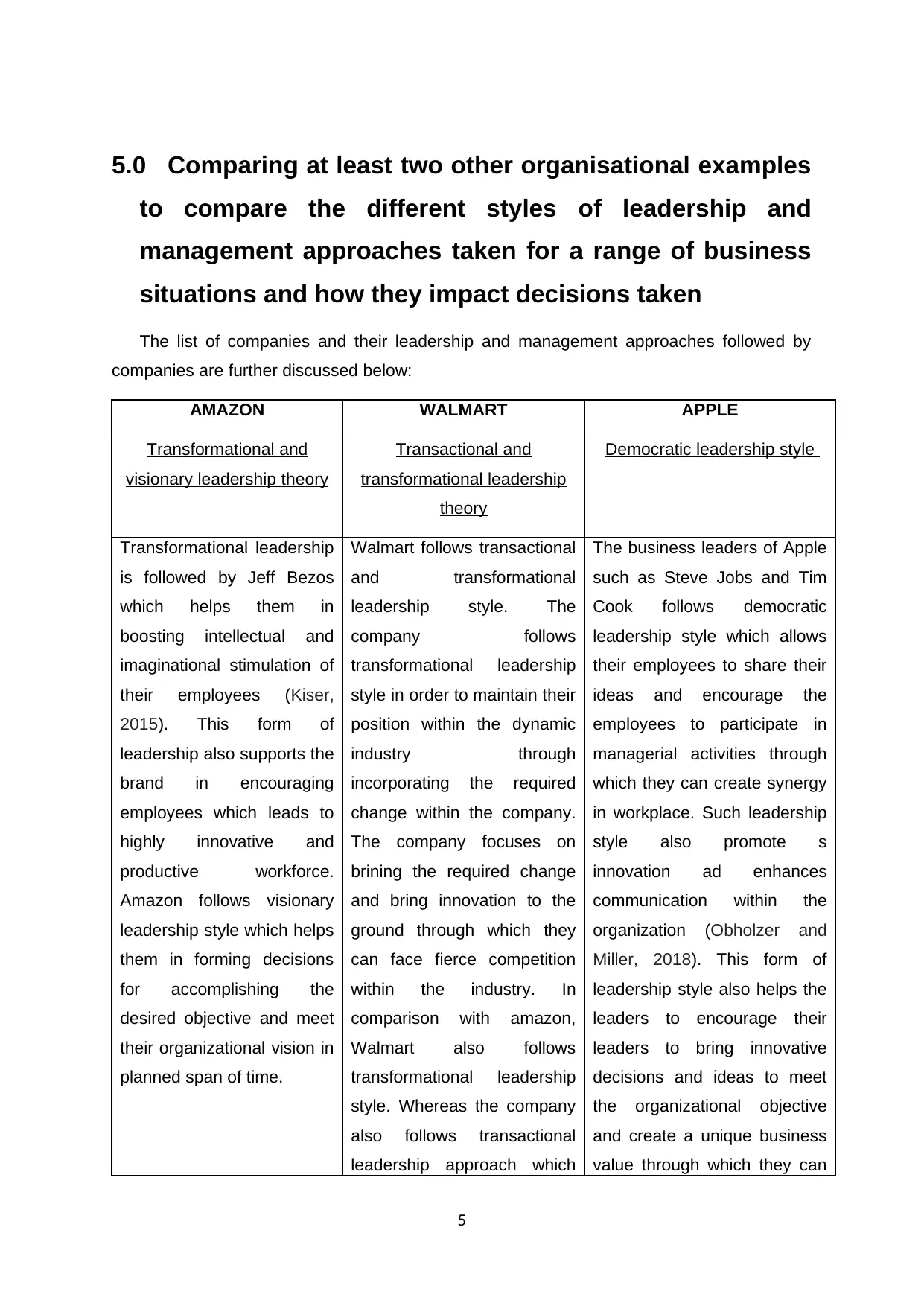
5.0 Comparing at least two other organisational examples
to compare the different styles of leadership and
management approaches taken for a range of business
situations and how they impact decisions taken
The list of companies and their leadership and management approaches followed by
companies are further discussed below:
AMAZON WALMART APPLE
Transformational and
visionary leadership theory
Transactional and
transformational leadership
theory
Democratic leadership style
Transformational leadership
is followed by Jeff Bezos
which helps them in
boosting intellectual and
imaginational stimulation of
their employees (Kiser,
2015). This form of
leadership also supports the
brand in encouraging
employees which leads to
highly innovative and
productive workforce.
Amazon follows visionary
leadership style which helps
them in forming decisions
for accomplishing the
desired objective and meet
their organizational vision in
planned span of time.
Walmart follows transactional
and transformational
leadership style. The
company follows
transformational leadership
style in order to maintain their
position within the dynamic
industry through
incorporating the required
change within the company.
The company focuses on
brining the required change
and bring innovation to the
ground through which they
can face fierce competition
within the industry. In
comparison with amazon,
Walmart also follows
transformational leadership
style. Whereas the company
also follows transactional
leadership approach which
The business leaders of Apple
such as Steve Jobs and Tim
Cook follows democratic
leadership style which allows
their employees to share their
ideas and encourage the
employees to participate in
managerial activities through
which they can create synergy
in workplace. Such leadership
style also promote s
innovation ad enhances
communication within the
organization (Obholzer and
Miller, 2018). This form of
leadership style also helps the
leaders to encourage their
leaders to bring innovative
decisions and ideas to meet
the organizational objective
and create a unique business
value through which they can
5
to compare the different styles of leadership and
management approaches taken for a range of business
situations and how they impact decisions taken
The list of companies and their leadership and management approaches followed by
companies are further discussed below:
AMAZON WALMART APPLE
Transformational and
visionary leadership theory
Transactional and
transformational leadership
theory
Democratic leadership style
Transformational leadership
is followed by Jeff Bezos
which helps them in
boosting intellectual and
imaginational stimulation of
their employees (Kiser,
2015). This form of
leadership also supports the
brand in encouraging
employees which leads to
highly innovative and
productive workforce.
Amazon follows visionary
leadership style which helps
them in forming decisions
for accomplishing the
desired objective and meet
their organizational vision in
planned span of time.
Walmart follows transactional
and transformational
leadership style. The
company follows
transformational leadership
style in order to maintain their
position within the dynamic
industry through
incorporating the required
change within the company.
The company focuses on
brining the required change
and bring innovation to the
ground through which they
can face fierce competition
within the industry. In
comparison with amazon,
Walmart also follows
transformational leadership
style. Whereas the company
also follows transactional
leadership approach which
The business leaders of Apple
such as Steve Jobs and Tim
Cook follows democratic
leadership style which allows
their employees to share their
ideas and encourage the
employees to participate in
managerial activities through
which they can create synergy
in workplace. Such leadership
style also promote s
innovation ad enhances
communication within the
organization (Obholzer and
Miller, 2018). This form of
leadership style also helps the
leaders to encourage their
leaders to bring innovative
decisions and ideas to meet
the organizational objective
and create a unique business
value through which they can
5
⊘ This is a preview!⊘
Do you want full access?
Subscribe today to unlock all pages.

Trusted by 1+ million students worldwide
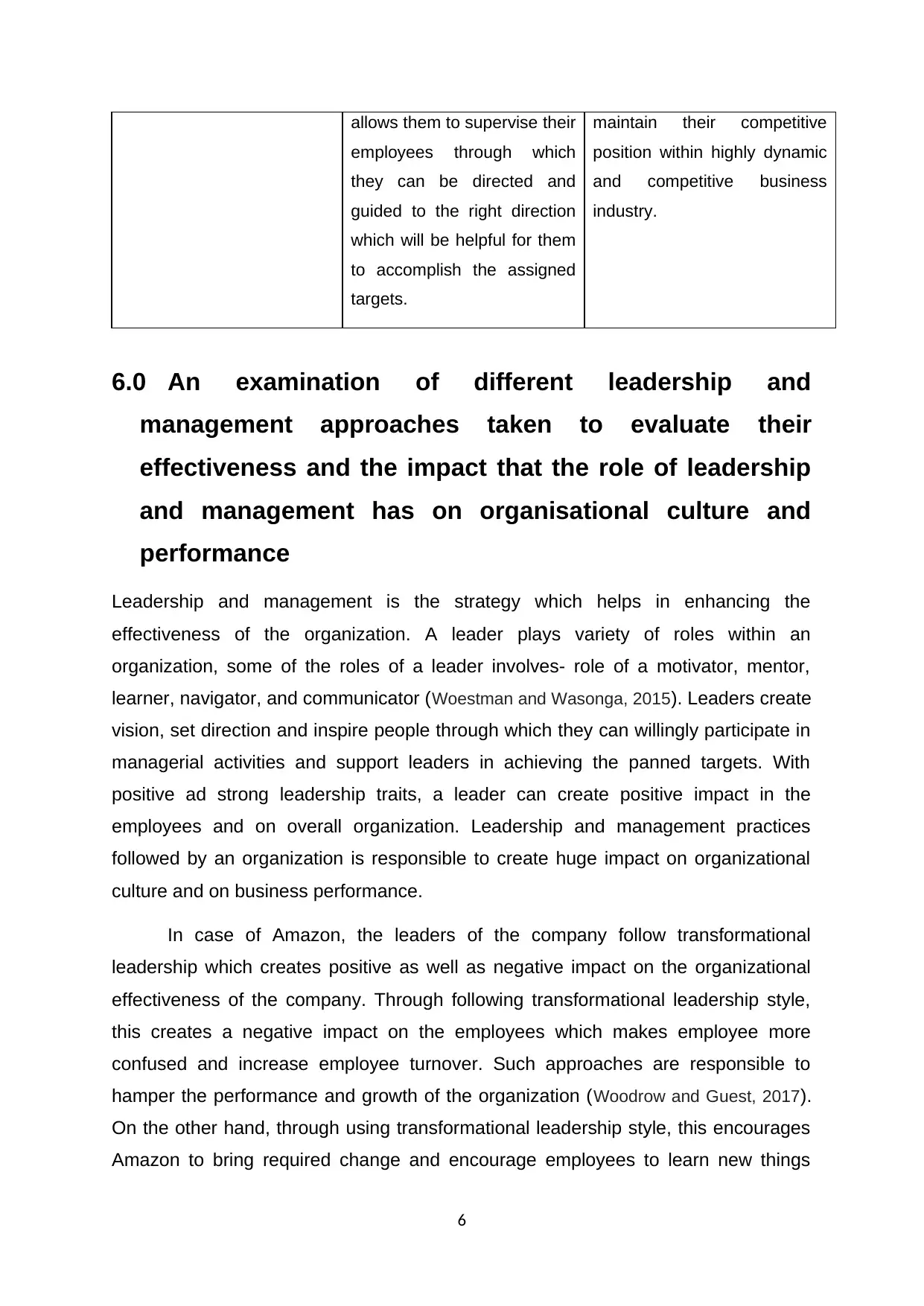
allows them to supervise their
employees through which
they can be directed and
guided to the right direction
which will be helpful for them
to accomplish the assigned
targets.
maintain their competitive
position within highly dynamic
and competitive business
industry.
6.0 An examination of different leadership and
management approaches taken to evaluate their
effectiveness and the impact that the role of leadership
and management has on organisational culture and
performance
Leadership and management is the strategy which helps in enhancing the
effectiveness of the organization. A leader plays variety of roles within an
organization, some of the roles of a leader involves- role of a motivator, mentor,
learner, navigator, and communicator (Woestman and Wasonga, 2015). Leaders create
vision, set direction and inspire people through which they can willingly participate in
managerial activities and support leaders in achieving the panned targets. With
positive ad strong leadership traits, a leader can create positive impact in the
employees and on overall organization. Leadership and management practices
followed by an organization is responsible to create huge impact on organizational
culture and on business performance.
In case of Amazon, the leaders of the company follow transformational
leadership which creates positive as well as negative impact on the organizational
effectiveness of the company. Through following transformational leadership style,
this creates a negative impact on the employees which makes employee more
confused and increase employee turnover. Such approaches are responsible to
hamper the performance and growth of the organization (Woodrow and Guest, 2017).
On the other hand, through using transformational leadership style, this encourages
Amazon to bring required change and encourage employees to learn new things
6
employees through which
they can be directed and
guided to the right direction
which will be helpful for them
to accomplish the assigned
targets.
maintain their competitive
position within highly dynamic
and competitive business
industry.
6.0 An examination of different leadership and
management approaches taken to evaluate their
effectiveness and the impact that the role of leadership
and management has on organisational culture and
performance
Leadership and management is the strategy which helps in enhancing the
effectiveness of the organization. A leader plays variety of roles within an
organization, some of the roles of a leader involves- role of a motivator, mentor,
learner, navigator, and communicator (Woestman and Wasonga, 2015). Leaders create
vision, set direction and inspire people through which they can willingly participate in
managerial activities and support leaders in achieving the panned targets. With
positive ad strong leadership traits, a leader can create positive impact in the
employees and on overall organization. Leadership and management practices
followed by an organization is responsible to create huge impact on organizational
culture and on business performance.
In case of Amazon, the leaders of the company follow transformational
leadership which creates positive as well as negative impact on the organizational
effectiveness of the company. Through following transformational leadership style,
this creates a negative impact on the employees which makes employee more
confused and increase employee turnover. Such approaches are responsible to
hamper the performance and growth of the organization (Woodrow and Guest, 2017).
On the other hand, through using transformational leadership style, this encourages
Amazon to bring required change and encourage employees to learn new things
6
Paraphrase This Document
Need a fresh take? Get an instant paraphrase of this document with our AI Paraphraser
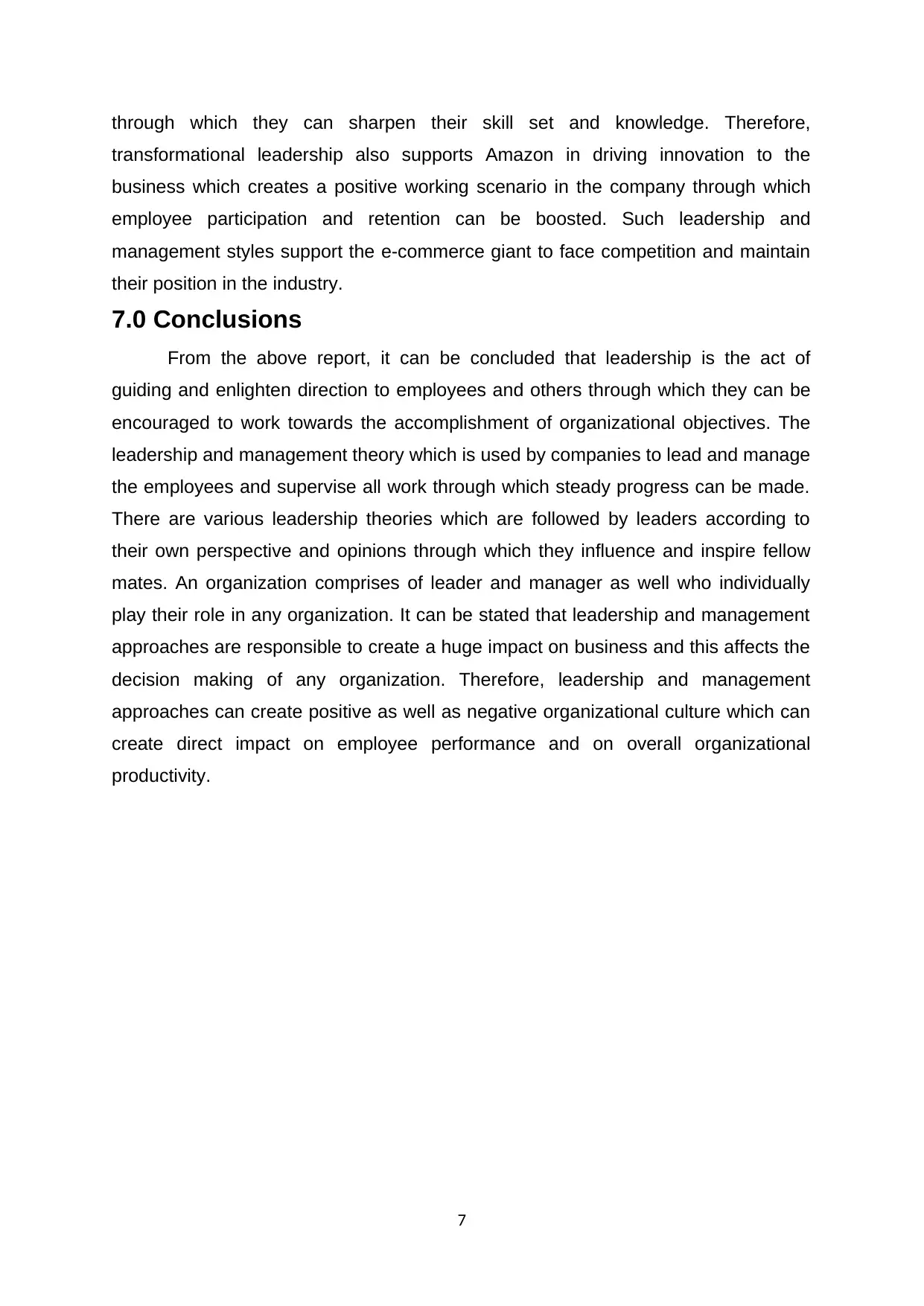
through which they can sharpen their skill set and knowledge. Therefore,
transformational leadership also supports Amazon in driving innovation to the
business which creates a positive working scenario in the company through which
employee participation and retention can be boosted. Such leadership and
management styles support the e-commerce giant to face competition and maintain
their position in the industry.
7.0 Conclusions
From the above report, it can be concluded that leadership is the act of
guiding and enlighten direction to employees and others through which they can be
encouraged to work towards the accomplishment of organizational objectives. The
leadership and management theory which is used by companies to lead and manage
the employees and supervise all work through which steady progress can be made.
There are various leadership theories which are followed by leaders according to
their own perspective and opinions through which they influence and inspire fellow
mates. An organization comprises of leader and manager as well who individually
play their role in any organization. It can be stated that leadership and management
approaches are responsible to create a huge impact on business and this affects the
decision making of any organization. Therefore, leadership and management
approaches can create positive as well as negative organizational culture which can
create direct impact on employee performance and on overall organizational
productivity.
7
transformational leadership also supports Amazon in driving innovation to the
business which creates a positive working scenario in the company through which
employee participation and retention can be boosted. Such leadership and
management styles support the e-commerce giant to face competition and maintain
their position in the industry.
7.0 Conclusions
From the above report, it can be concluded that leadership is the act of
guiding and enlighten direction to employees and others through which they can be
encouraged to work towards the accomplishment of organizational objectives. The
leadership and management theory which is used by companies to lead and manage
the employees and supervise all work through which steady progress can be made.
There are various leadership theories which are followed by leaders according to
their own perspective and opinions through which they influence and inspire fellow
mates. An organization comprises of leader and manager as well who individually
play their role in any organization. It can be stated that leadership and management
approaches are responsible to create a huge impact on business and this affects the
decision making of any organization. Therefore, leadership and management
approaches can create positive as well as negative organizational culture which can
create direct impact on employee performance and on overall organizational
productivity.
7
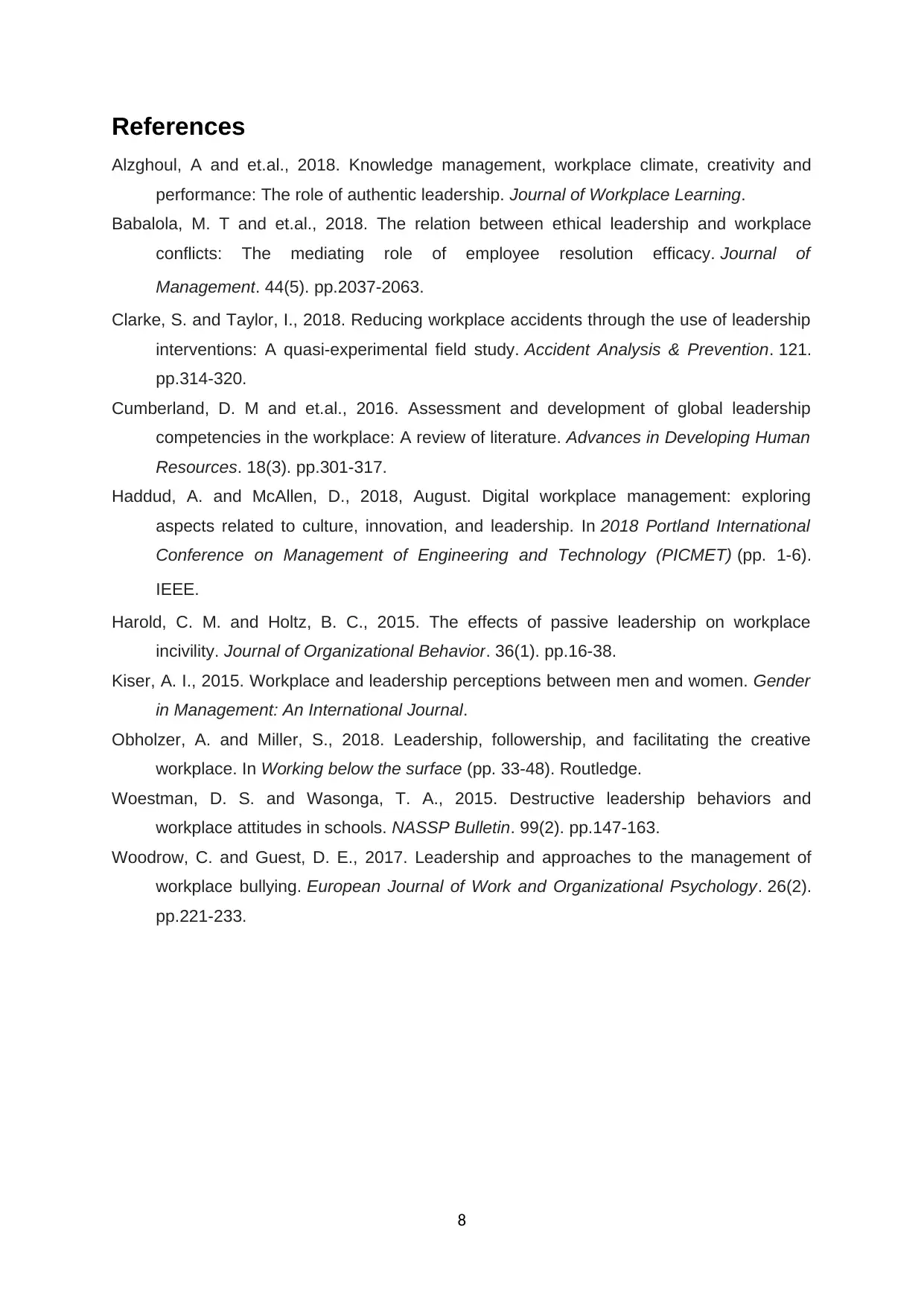
References
Alzghoul, A and et.al., 2018. Knowledge management, workplace climate, creativity and
performance: The role of authentic leadership. Journal of Workplace Learning.
Babalola, M. T and et.al., 2018. The relation between ethical leadership and workplace
conflicts: The mediating role of employee resolution efficacy. Journal of
Management. 44(5). pp.2037-2063.
Clarke, S. and Taylor, I., 2018. Reducing workplace accidents through the use of leadership
interventions: A quasi-experimental field study. Accident Analysis & Prevention. 121.
pp.314-320.
Cumberland, D. M and et.al., 2016. Assessment and development of global leadership
competencies in the workplace: A review of literature. Advances in Developing Human
Resources. 18(3). pp.301-317.
Haddud, A. and McAllen, D., 2018, August. Digital workplace management: exploring
aspects related to culture, innovation, and leadership. In 2018 Portland International
Conference on Management of Engineering and Technology (PICMET) (pp. 1-6).
IEEE.
Harold, C. M. and Holtz, B. C., 2015. The effects of passive leadership on workplace
incivility. Journal of Organizational Behavior. 36(1). pp.16-38.
Kiser, A. I., 2015. Workplace and leadership perceptions between men and women. Gender
in Management: An International Journal.
Obholzer, A. and Miller, S., 2018. Leadership, followership, and facilitating the creative
workplace. In Working below the surface (pp. 33-48). Routledge.
Woestman, D. S. and Wasonga, T. A., 2015. Destructive leadership behaviors and
workplace attitudes in schools. NASSP Bulletin. 99(2). pp.147-163.
Woodrow, C. and Guest, D. E., 2017. Leadership and approaches to the management of
workplace bullying. European Journal of Work and Organizational Psychology. 26(2).
pp.221-233.
8
Alzghoul, A and et.al., 2018. Knowledge management, workplace climate, creativity and
performance: The role of authentic leadership. Journal of Workplace Learning.
Babalola, M. T and et.al., 2018. The relation between ethical leadership and workplace
conflicts: The mediating role of employee resolution efficacy. Journal of
Management. 44(5). pp.2037-2063.
Clarke, S. and Taylor, I., 2018. Reducing workplace accidents through the use of leadership
interventions: A quasi-experimental field study. Accident Analysis & Prevention. 121.
pp.314-320.
Cumberland, D. M and et.al., 2016. Assessment and development of global leadership
competencies in the workplace: A review of literature. Advances in Developing Human
Resources. 18(3). pp.301-317.
Haddud, A. and McAllen, D., 2018, August. Digital workplace management: exploring
aspects related to culture, innovation, and leadership. In 2018 Portland International
Conference on Management of Engineering and Technology (PICMET) (pp. 1-6).
IEEE.
Harold, C. M. and Holtz, B. C., 2015. The effects of passive leadership on workplace
incivility. Journal of Organizational Behavior. 36(1). pp.16-38.
Kiser, A. I., 2015. Workplace and leadership perceptions between men and women. Gender
in Management: An International Journal.
Obholzer, A. and Miller, S., 2018. Leadership, followership, and facilitating the creative
workplace. In Working below the surface (pp. 33-48). Routledge.
Woestman, D. S. and Wasonga, T. A., 2015. Destructive leadership behaviors and
workplace attitudes in schools. NASSP Bulletin. 99(2). pp.147-163.
Woodrow, C. and Guest, D. E., 2017. Leadership and approaches to the management of
workplace bullying. European Journal of Work and Organizational Psychology. 26(2).
pp.221-233.
8
⊘ This is a preview!⊘
Do you want full access?
Subscribe today to unlock all pages.

Trusted by 1+ million students worldwide

Table of Content
Part 2: Presentation
9
Part 2: Presentation
9
1 out of 10
Related Documents
Your All-in-One AI-Powered Toolkit for Academic Success.
+13062052269
info@desklib.com
Available 24*7 on WhatsApp / Email
![[object Object]](/_next/static/media/star-bottom.7253800d.svg)
Unlock your academic potential
Copyright © 2020–2025 A2Z Services. All Rights Reserved. Developed and managed by ZUCOL.

